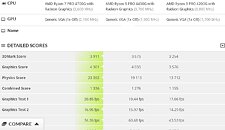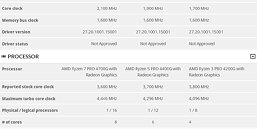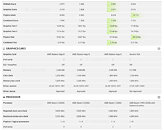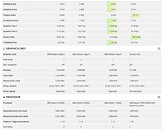Thursday, May 28th 2020

Benchmarks Surface for AMD Ryzen 4700G, 4400G and 4200G Renoir APUs
Renowned leaker APISAK has digged up benchmarks for AMD's upcoming Ryzen 4700G, 4400G and 4200G Renoir APUs in 3D Mark. These are actually for the PRO versions of the APUs, but these tend to be directly comparable with AMD's non-PRO offerings, so we can look at them to get an idea of where AMD's 4000G series' performance lies. AMD's 4000G will be increasing core-counts almost across the board - the midrange 4400G now sports 6 cores and 12 threads, which is more than the previous generation Ryzen 5 3400G offered (4 cores / 8 threads), while the top-of-the-line 4700G doubles the 3400G's core-cpount to 8 physical and 16 logical threads.
This increase in CPU cores, of course, has implied a reduction in the area of the chip that's dedicated to the integrated Vega graphics GPU - compute units have been reduced from the 3400G's 11 down to 8 compute units on the Ryzen 7 4700G and 7 compute units on the 4400G - while the 4200G now makes do with just 6 Vega compute units. Clocks have been severely increased across the board to compensate the CU reduction, though - the aim is to achieve similar GPU performance using a smaller amount of semiconductor real-estate.The 4700G's 8 Vega CUs clocked at 2.1 GHz, as reported by the benchmark suite, achieve 4,301 points in the graphics and 23,392 points in the CPU score, which are respectively 6.65% and 22.3% higher than the 4400G's 4,033 and 19,113 points (achieved with the same 8 Vega CUs clocked at a slower 1.9 GHz and with two fewer cores. The 4700G scores 20% and a whopping 70.6% higher than the 4200G's in the graphics and physics tests respectively - which makes sense, considering the slower-clocked 6 Vega CUs (1.7 GHz) and 4 core / 8 thread configuration of the former. AMD's 4000G series keeps the same 65 W TDp despite higher number of CPU cores and higher-clocked Vega cores, but the company will also have Ryzen 400=GE series which achieve a 35 W TDP, albeit at the cost of reduced CPU clocks (and likely GPU clocks as well).
_rogame, another well-known leaker, found two comparable system configurations running the Ryzen 4200G and 3200G, where the 4200G delivered 57% higher CPU performance, but 7% less GPU performance.
Sources:
via Videocardz, APISAK @ Twitter, _rogame @ Twitter
This increase in CPU cores, of course, has implied a reduction in the area of the chip that's dedicated to the integrated Vega graphics GPU - compute units have been reduced from the 3400G's 11 down to 8 compute units on the Ryzen 7 4700G and 7 compute units on the 4400G - while the 4200G now makes do with just 6 Vega compute units. Clocks have been severely increased across the board to compensate the CU reduction, though - the aim is to achieve similar GPU performance using a smaller amount of semiconductor real-estate.The 4700G's 8 Vega CUs clocked at 2.1 GHz, as reported by the benchmark suite, achieve 4,301 points in the graphics and 23,392 points in the CPU score, which are respectively 6.65% and 22.3% higher than the 4400G's 4,033 and 19,113 points (achieved with the same 8 Vega CUs clocked at a slower 1.9 GHz and with two fewer cores. The 4700G scores 20% and a whopping 70.6% higher than the 4200G's in the graphics and physics tests respectively - which makes sense, considering the slower-clocked 6 Vega CUs (1.7 GHz) and 4 core / 8 thread configuration of the former. AMD's 4000G series keeps the same 65 W TDp despite higher number of CPU cores and higher-clocked Vega cores, but the company will also have Ryzen 400=GE series which achieve a 35 W TDP, albeit at the cost of reduced CPU clocks (and likely GPU clocks as well).
_rogame, another well-known leaker, found two comparable system configurations running the Ryzen 4200G and 3200G, where the 4200G delivered 57% higher CPU performance, but 7% less GPU performance.




37 Comments on Benchmarks Surface for AMD Ryzen 4700G, 4400G and 4200G Renoir APUs
this is a very fast cpu paired with a gpu that'll let you run games at 1080p.
run,not play.
Or dual channel memory bandwidth of around 80 GB/s which is not bad and you will be able to play select modern games.
These new APU's will be clocked much higher at stock. :toast:
iGPU is there to just show something on the screen, not to play. Even tho amd and intel both try to cram better graphics from time to time, it is uselessly increasing cpu power consumption while achieving the similar results.
iGPU are also used for home server builds/NAS.
i've built a pc for my mom using a i5 2500, and it is doing its job just fine. She is playing games like candy crush and alike, no problem.
Everything isn't gaming there's a lot of workloads out there and certainly AMD don't want to canibalise their low end GPUs either.
I think APUs are a good way to get people on a budget 'in' gaming, kind of getting their feet wet with the option to upgrade to a discrete GPU later on.
Personally I'm super stocked to get my hands on an APU equivalent to a 4900HS because I'll put it in a home server to run VMs, docker, etc without having to break the bank on new server hardware or use old ones that gulp down power (I want my power budget to be around 50W idle at the wall)
I also hope Asrock or someone updates the A300 with a motherboard that will support renoir APUs ..fingers crossed I guess
And it's coming, by the way, especially in the laptop market, where it will eat from the geforce mx market share:
For the 4700G and even the 4400G to both get more CUs than the mobile variants seems odd, especially where the mobile variants with no way to upgrade to a dGPU later need it more.
I dunno, maybe the IGPs were thrown under the bus in the U-series for the sake of power targets, which is a tragedy because the graphics portion of an AMD APU is what made ultraportables competent at 3D work. If people wanted decent CPU performance and didn't give a damn about graphics, there was always a better Intel laptop option at 15W.I may have to watch that in its entirety, despite that dude's offensively awful T-shirt.
PS4/5 and Xbox one * have way more memory bandwidth than any pc APU.
Looking at a console side of things. You should not compare any console to a PC.
Why not low power iGPU? Because there's a demand for something with more kick.
They added CUs were faster, but just not fast enough to matter.
DDR4-3200 seems to be the baseline for Renoir designs, so there's 50% more bandwidth already and if you look at the Athlon 3000G with only 3CUs, it was very definitely short on CUs. Even in single-channel mode, that thing couldn't use the pathetic bandwidth it was given because 3CUs isn't enough, and adding more RAM or faster RAM did very little for the 3000G.
I'm guessing that 6CU configurations or Renoir will not be bandwidth starved like Vega10 and Vega11 were, and that Renoir's Vega8 with LPDDR4X will be entirely limited by the small number of CUs.
Budget gamers and laptop users with decent cooling will wish there was a Vega12 or Vega15 offering, as was originally rumoured. Compared to the rest of the APU, the actual CUs are tiny, so downgrading from 11 in Pinnacle Ridge APUs to 8 in Renoir is a deep cut that hasn't really reduced die area by all that much. False economy IMO but only time will tell if AMD correct that mistake in the 5000-series or abandon higher GPU capabilities in the APUs going forward.